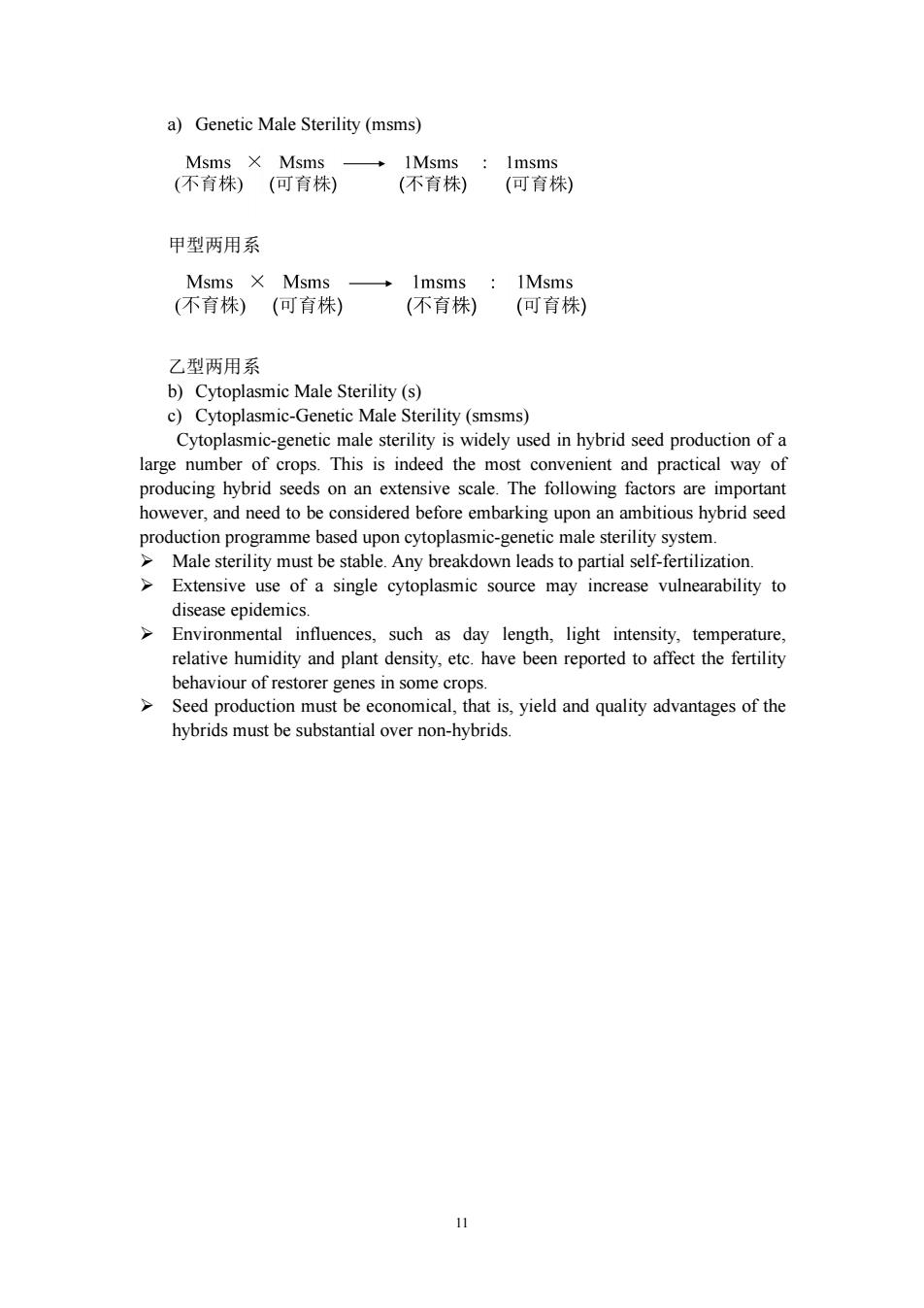
a)Genetic Male Sterility (msms) Msms X Msms 1Msms Imsms (不育株)(可育株) (不育株) (可育株) 甲型两用系 Msms X Msms 1msms:1Msms (不育株)(可育株) (不育株) (可育株) 乙型两用系 b)Cytoplasmic Male Sterility(s) c)Cytoplasmic-Genetic Male Sterility (smsms) Cytoplasmic-genetic male sterility is widely used in hybrid seed production of a large number of crops.This is indeed the most convenient and practical way of producing hybrid seeds on an extensive scale.The following factors are important however,and need to be considered before embarking upon an ambitious hybrid seed production programme based upon cytoplasmic-genetic male sterility system. Male sterility must be stable.Any breakdown leads to partial self-fertilization. >Extensive use of a single cytoplasmic source may increase vulnearability to disease epidemics. Environmental influences,such as day length,light intensity,temperature, relative humidity and plant density,etc.have been reported to affect the fertility behaviour of restorer genes in some crops. Seed production must be economical,that is,yield and quality advantages of the hybrids must be substantial over non-hybrids
11 a) Genetic Male Sterility (msms) 甲型两用系 乙型两用系 b) Cytoplasmic Male Sterility (s) c) Cytoplasmic-Genetic Male Sterility (smsms) Cytoplasmic-genetic male sterility is widely used in hybrid seed production of a large number of crops. This is indeed the most convenient and practical way of producing hybrid seeds on an extensive scale. The following factors are important however, and need to be considered before embarking upon an ambitious hybrid seed production programme based upon cytoplasmic-genetic male sterility system. Male sterility must be stable. Any breakdown leads to partial self-fertilization. Extensive use of a single cytoplasmic source may increase vulnearability to disease epidemics. Environmental influences, such as day length, light intensity, temperature, relative humidity and plant density, etc. have been reported to affect the fertility behaviour of restorer genes in some crops. Seed production must be economical, that is, yield and quality advantages of the hybrids must be substantial over non-hybrids
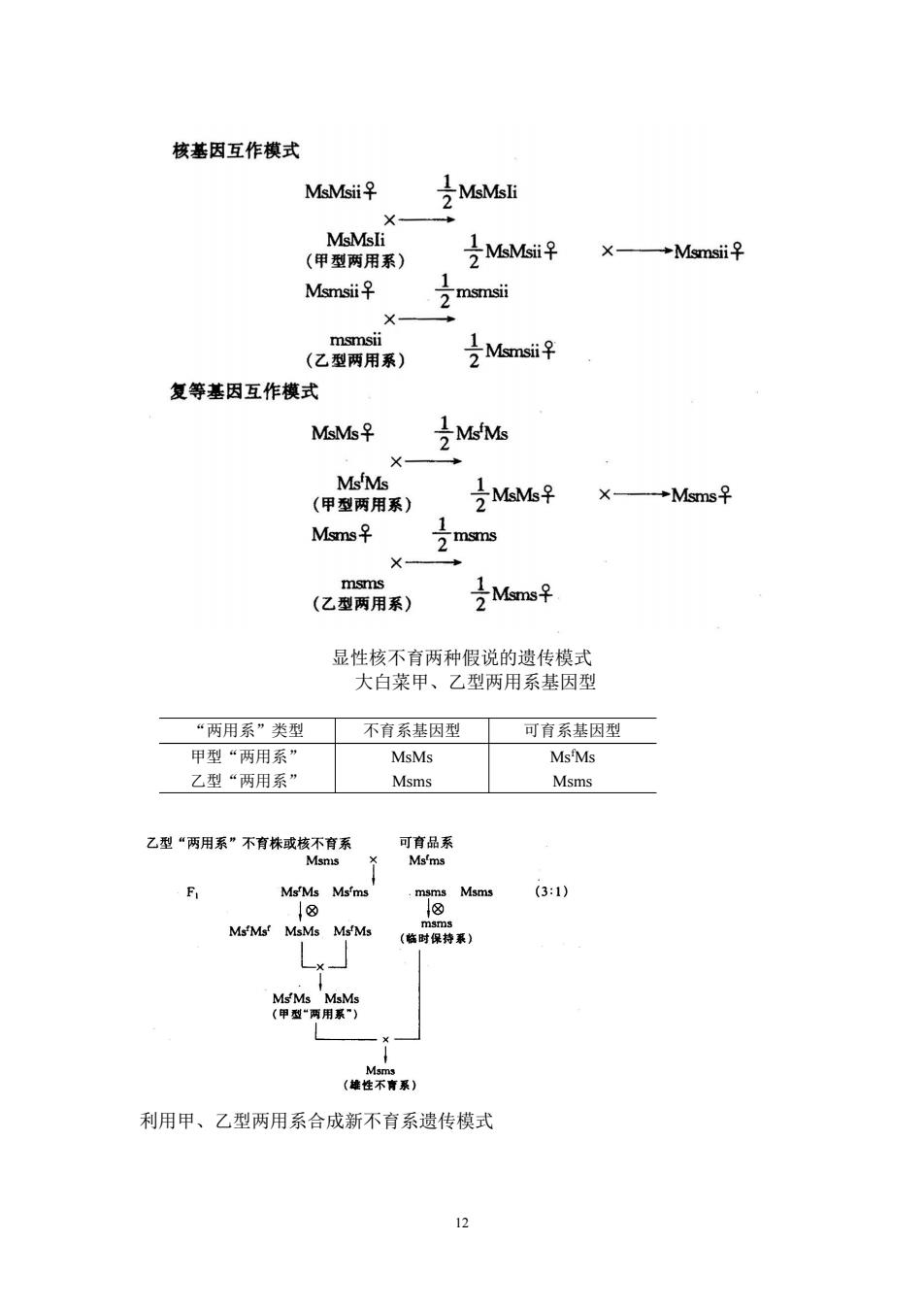
核基因互作模式 MsMsii♀ MsMsIi 2 X- MsMsIi (甲型两用系) MMsi早 X+Msmsii♀ Msmsii♀ smsii 1 X- msmsii (乙型两用系) 受Mi-¥ 复等基因互作模式 MsMs♀ 子MM Ms'Ms (甲型两用系) M6字 X→Msms♀ Msms♀ 1 2 msms X msms (乙型两用系) Msms♀ 2 显性核不育两种假说的遗传模式 大白菜甲、乙型两用系基因型 “两用系”类型 不育系基因型 可育系基因型 甲型“两用系” MsMs Ms'Ms 乙型“两用系” Msms Msms 乙型“两用系”不育株或核不育系 可育品系 Msms Ms'ms F Ms'Ms Ms'ms :msms Msms (3:1) 1⑧ ⑧ Ms'Ms'MsMs Ms'Ms msms (临时保持系) Ms'Ms MsMs (甲型“两用系”) Msms (雄性不青系) 利用甲、乙型两用系合成新不育系遗传模式 白
12 显性核不育两种假说的遗传模式 大白菜甲、乙型两用系基因型 “两用系”类型 不育系基因型 可育系基因型 甲型“两用系” 乙型“两用系” MsMs Msms Ms fMs Msms 利用甲、乙型两用系合成新不育系遗传模式
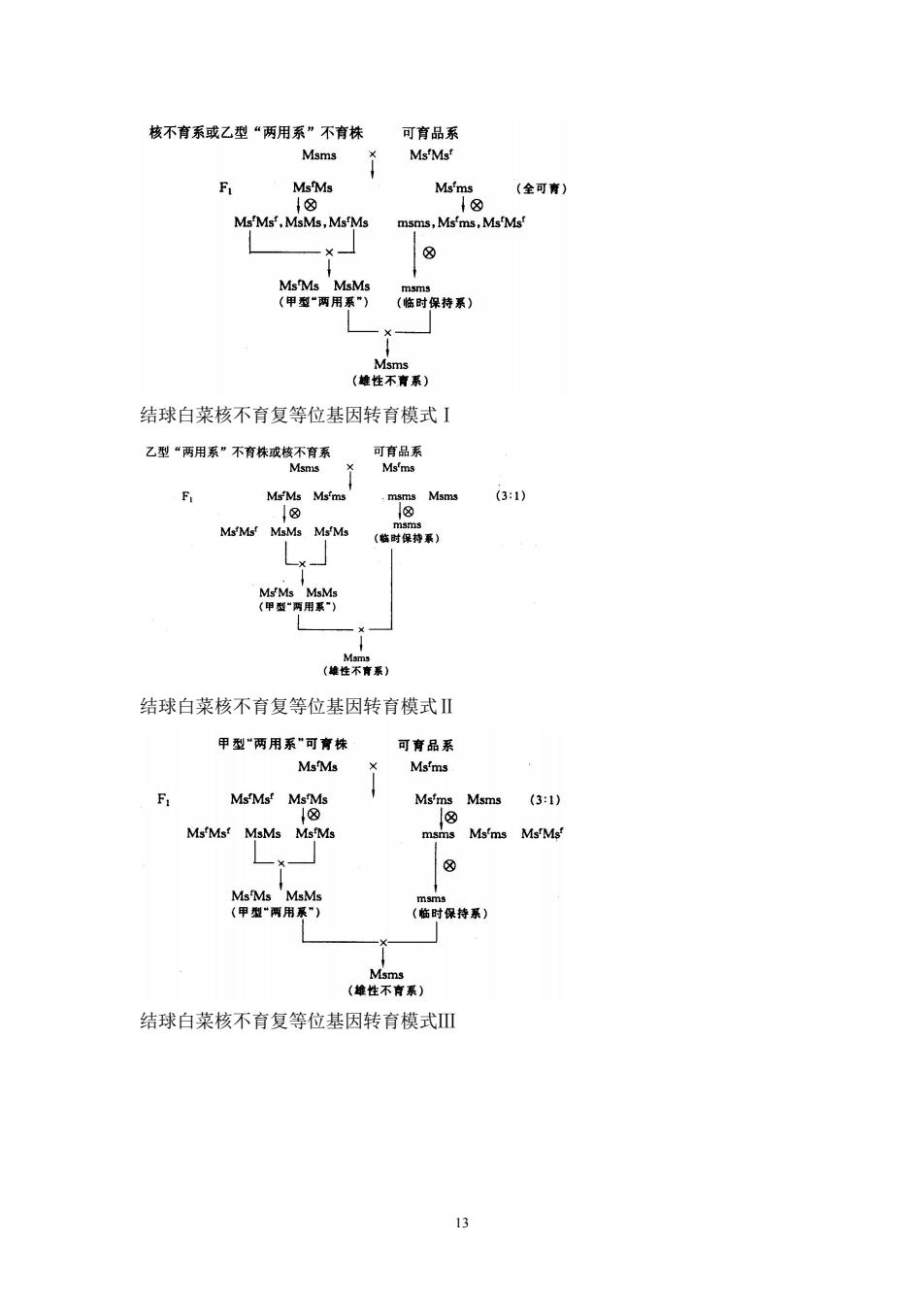
核不育系或乙型“两用系”不育株 可育品系 Msms Ms'Msf F MsMs Ms'ms (全可育) 1⑧ ⑧ Ms'Ms',MsMs,Ms'Ms msms,Ms'ms,Ms'Ms ⑧ MsMs MsMs msms (甲型“两用系) (临时保持系) Msms (雄性不青系) 结球白菜核不育复等位基因转育模式I 乙型“两用系”不育株或核不育系 可育品系 Msms Ms'ms F Ms'Ms Ms'ms .msmsMsms (3:1) msms Ms'Mst MsMs Ms'Ms (临时保持系) Ms'Ms MsMs (甲型“两用累”) Msms (雄性不青系) 结球白菜核不育复等位基因转育模式Ⅱ 甲型“两用系"可有株 可育品系 MsMs Ms'ms F Ms'Ms!Ms'Ms Ms'ms Msms (3:1) 1⑧ Ms'Ms' MsMs Ms'Ms msms Ms'ms Ms'Ms ⑧ Ms'Ms MsMs msms (甲型“两用暴”) (临时保持系) Msms (雄性不有系) 结球白菜核不育复等位基因转育模式Ⅱ 3
13 结球白菜核不育复等位基因转育模式Ⅰ 结球白菜核不育复等位基因转育模式Ⅱ 结球白菜核不育复等位基因转育模式Ⅲ
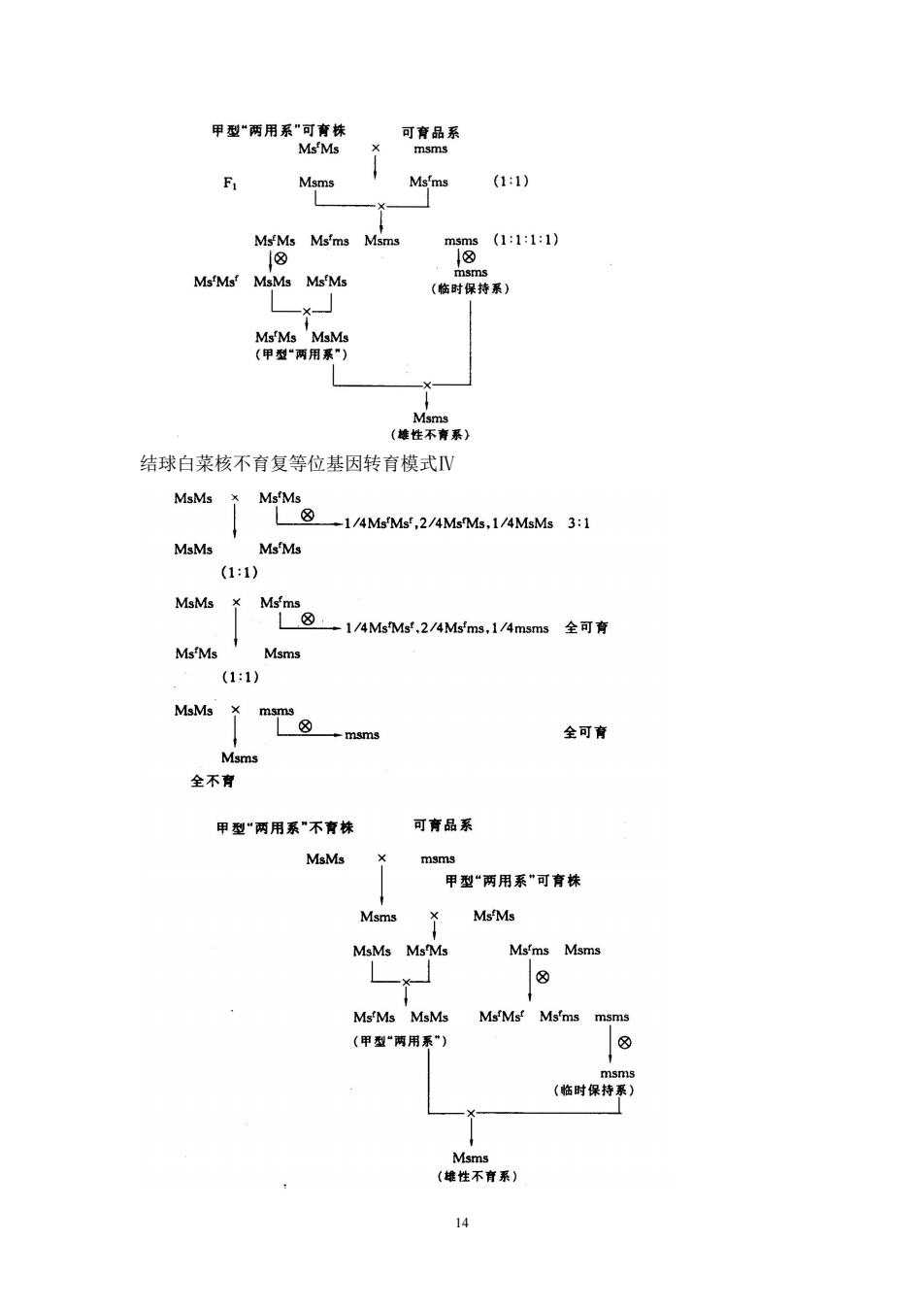
甲型“两用系”可育株 可育品系 Ms'Ms + msms F Msms Ms'ms (1:1) Ms'Ms Ms'ms Msms msms (1:1:1:1) 1⑧ 18 Ms'Ms'MsMs Ms'Ms msms (临时保持系) Ms'Ms'MsMs (甲型“两用系”) Msms (雄性不青系) 结球白菜核不育复等位基因转育模式Ⅳ MsMs Ms'Ms L⑧ 1/4Ms'Ms',2/4Ms'Ms,1/4MsMs 3:1 MsMs Ms'Ms (1:1) MsMs Ms'ms 1/4Ms'Ms'.2/4Ms'ms.1/4msms 全可育 Ms'Ms Msms (1:1) MsMs x msms ⑧ -msms 全可育 Msms 全不育 甲型“两用系”不育株 可育品系 MsMs msms 甲型“两用系”可育株 Msms MsMs MsMs MsMs Ms'ms Msms 田 Ms'Ms MsMs Ms'Mst Ms'ms msms (甲型“两用系") ⑧ msms (临时保持系) Msms (雄性不育系) 14
14 结球白菜核不育复等位基因转育模式Ⅳ
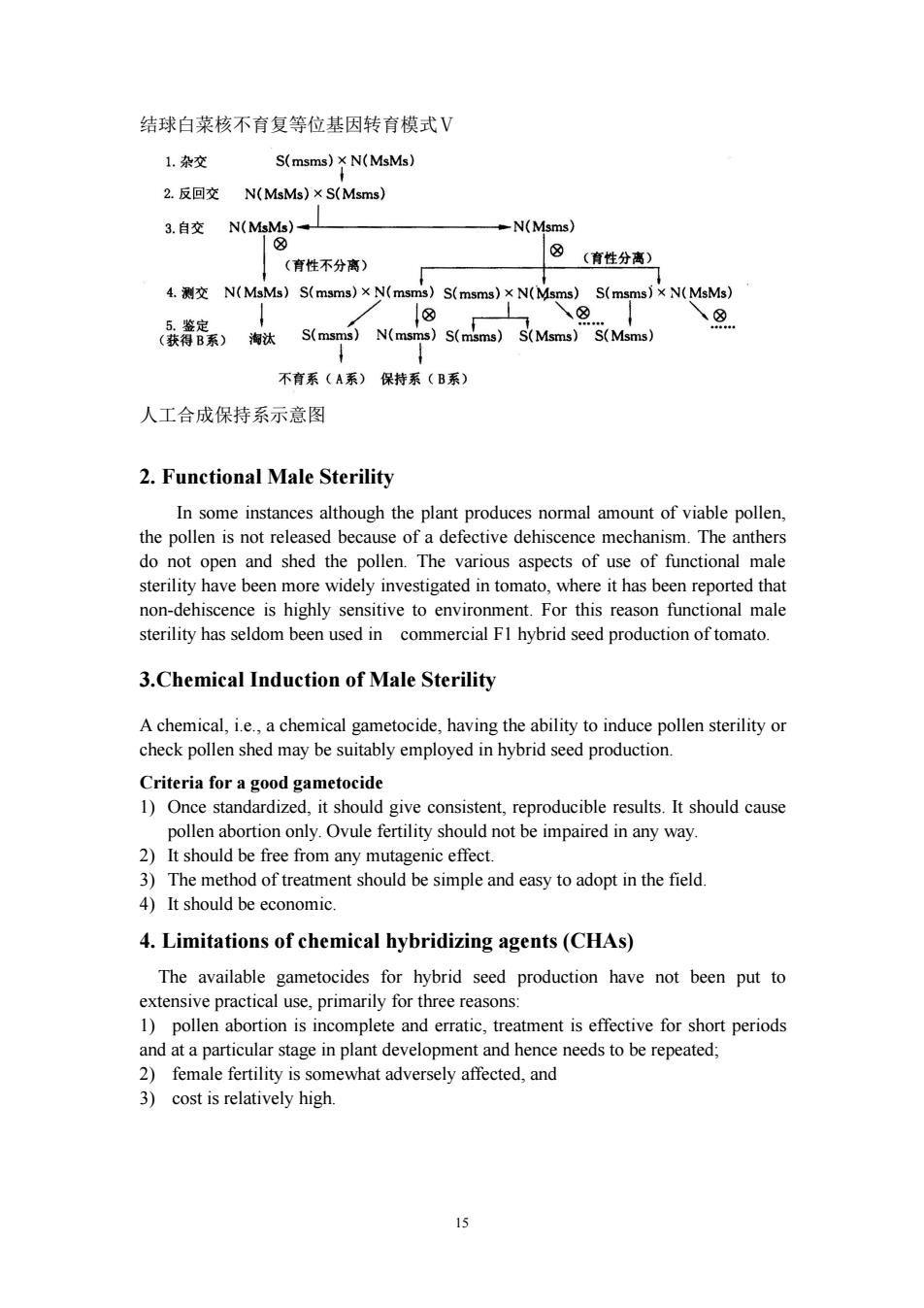
结球白菜核不育复等位基因转育模式V 1.杂交 S(msms)×N(MsMs) 2.反回交 N(MsMs)×s(Msms) 3.自交 N(MsMs) -N(Msms) 1⑧ ⊕ (育性不分离) (育性分离) 4.测交N(MsMs)S(msms)×N(msms)S(msms)×N(Msms)S(msms)×N(MsMs) ⑧ 5.鉴定 (获得B系) 海汰 S(msms)N(msms)S(msms)S(Msms)S(Msms) 不育系(A系)保持系(B系) 人工合成保持系示意图 2.Functional Male Sterility In some instances although the plant produces normal amount of viable pollen, the pollen is not released because of a defective dehiscence mechanism.The anthers do not open and shed the pollen.The various aspects of use of functional male sterility have been more widely investigated in tomato,where it has been reported that non-dehiscence is highly sensitive to environment.For this reason functional male sterility has seldom been used in commercial FI hybrid seed production of tomato. 3.Chemical Induction of Male Sterility A chemical,i.e.,a chemical gametocide,having the ability to induce pollen sterility or check pollen shed may be suitably employed in hybrid seed production. Criteria for a good gametocide 1)Once standardized,it should give consistent,reproducible results.It should cause pollen abortion only.Ovule fertility should not be impaired in any way. 2)It should be free from any mutagenic effect. 3)The method of treatment should be simple and easy to adopt in the field. 4)It should be economic. 4.Limitations of chemical hybridizing agents (CHAs) The available gametocides for hybrid seed production have not been put to extensive practical use,primarily for three reasons: 1)pollen abortion is incomplete and erratic,treatment is effective for short periods and at a particular stage in plant development and hence needs to be repeated; 2)female fertility is somewhat adversely affected,and 3)cost is relatively high. 15
15 结球白菜核不育复等位基因转育模式Ⅴ 人工合成保持系示意图 2. Functional Male Sterility In some instances although the plant produces normal amount of viable pollen, the pollen is not released because of a defective dehiscence mechanism. The anthers do not open and shed the pollen. The various aspects of use of functional male sterility have been more widely investigated in tomato, where it has been reported that non-dehiscence is highly sensitive to environment. For this reason functional male sterility has seldom been used in commercial F1 hybrid seed production of tomato. 3.Chemical Induction of Male Sterility A chemical, i.e., a chemical gametocide, having the ability to induce pollen sterility or check pollen shed may be suitably employed in hybrid seed production. Criteria for a good gametocide 1) Once standardized, it should give consistent, reproducible results. It should cause pollen abortion only. Ovule fertility should not be impaired in any way. 2) It should be free from any mutagenic effect. 3) The method of treatment should be simple and easy to adopt in the field. 4) It should be economic. 4. Limitations of chemical hybridizing agents (CHAs) The available gametocides for hybrid seed production have not been put to extensive practical use, primarily for three reasons: 1) pollen abortion is incomplete and erratic, treatment is effective for short periods and at a particular stage in plant development and hence needs to be repeated; 2) female fertility is somewhat adversely affected, and 3) cost is relatively high